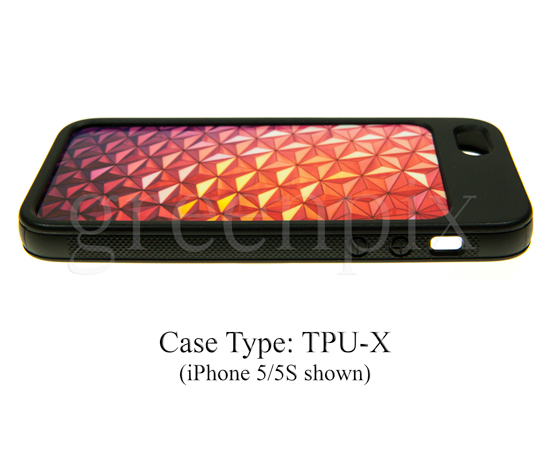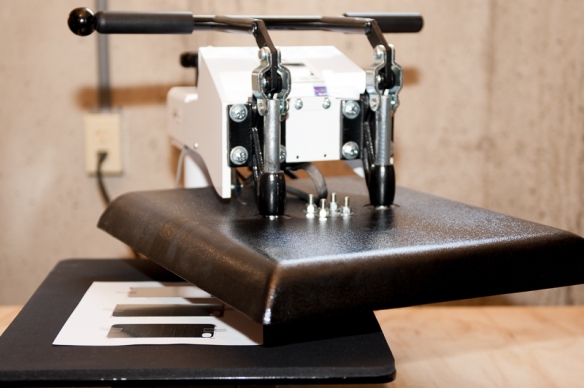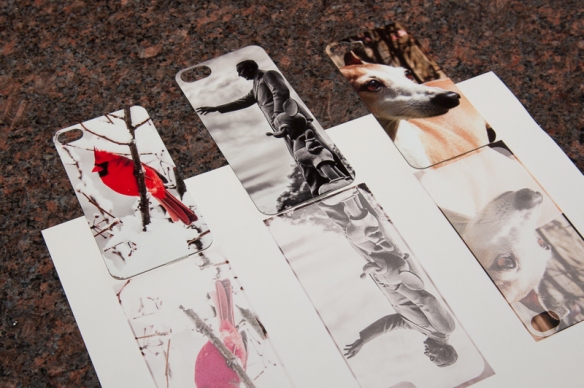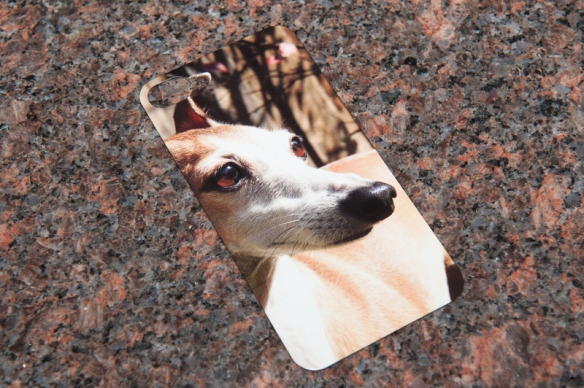I sell many types and styles of cell phone cases in my Etsy shop, and I print and sublimate the majority of them right here in my Pennsylvania studio. Since I often get questions regarding the differences between the various types of cases, or why the prices vary so much, I thought it would be a good idea to offer a thorough explanation of the various cases that I offer, why they are priced as they are, and how they can be expected to perform in real life situations. I also thought this would be a good opportunity to compare my cases to those of the competition, so that as a consumer, you can shop wisely and know that you are getting a good value. So, without further preamble, …
PLASTIC WITH PERMANENT ALUMINUM INSERT (Greenpix Code: PLA)
This is the most basic type of case you will find. Supplies are inexpensive and readily available, the cases are easy to make, and the sublimation process used to transfer the image to the aluminum can produce a stunning image. I can’t find anyone who can tell me exactly what type of plastic is used to make these, but I suspect it’s a low density polyethylene (like a soda bottle). Most phone case sellers on Etsy and similar sites offer this type of case, and so do many of the shopping mall kiosks and overseas commercial (re)sellers. I offer a few of these, mainly as special requests, to folks who like the look and feel of the glossy plastic. I also have a few stock designs that I offer at discounted prices. But beware – these cases look and feel a bit cheap, they break somewhat easily, and they don’t offer much in the way of protection for your phone. Here’s an example:

 Regarding pricing, I’ve seen the exact same cases selling anywhere between $7.00 and $40.00. Without getting too specific, my personal opinion is that their value is closer to the lower end of that range. Considering that the cases are more decorative than functional, and won’t hold up too well if used regularly, paying any more than about $12.00 or $15.00 for one of these is just silly, and paying $30.00 or $40.00 is an outright waste of your hard-earned money.
Regarding pricing, I’ve seen the exact same cases selling anywhere between $7.00 and $40.00. Without getting too specific, my personal opinion is that their value is closer to the lower end of that range. Considering that the cases are more decorative than functional, and won’t hold up too well if used regularly, paying any more than about $12.00 or $15.00 for one of these is just silly, and paying $30.00 or $40.00 is an outright waste of your hard-earned money.
TPU WITH PERMANENT ALUMINUM INSERT (Greenpix Code: TPU)
This type of case is very similar to the plastic case described above, with the main difference being the material used for the case itself. TPU (thermoplastic polyurethane) is a durable, flexible, rubber-like material. TPU does a better job protecting your phone, offers a nice hand grip, and won’t break like the plastic. The aluminum inserts are the same, so they can look very impressive. Here’s an example:

 I sell a lot of these in my shop, and think I have them priced pretty fairly (around $15.00), considering the quality of the materials and the anticipated life of the case. Nothing is likely to happen to the rubber case itself, but the inserts are not scratch-proof, and although they can flex a little, they can also acquire a permanent bend if you’re not very careful when removing the case from your phone or if you’re in the habit of sitting down with your phone in the back pocket of your jeans. This is a great option if you’re looking for an attractive, moderately priced case that won’t see a lot of abuse. Is it worth more than $20.00? No way!
I sell a lot of these in my shop, and think I have them priced pretty fairly (around $15.00), considering the quality of the materials and the anticipated life of the case. Nothing is likely to happen to the rubber case itself, but the inserts are not scratch-proof, and although they can flex a little, they can also acquire a permanent bend if you’re not very careful when removing the case from your phone or if you’re in the habit of sitting down with your phone in the back pocket of your jeans. This is a great option if you’re looking for an attractive, moderately priced case that won’t see a lot of abuse. Is it worth more than $20.00? No way!
CASES WITH INTERCHANGEABLE ALUMINUM INSERTS
This clever concept, which doesn’t require the use of any adhesive, offers two money-saving advantages: 1. You can change the look of your phone by simply swapping out the insert, not the entire case. If you want a snowy scene for winter and tulips for spring, no problem – just replace your insert. 2. If you do scratch or otherwise damage your insert, still no problem – keep the case and buy just a new insert at a reduced price. Another advantage of these cases is that the inserts are different (better, I’ve found) than those used in the adhesive versions. The sublimated image quality is superior, as is the scratch and abrasion resistance. Also, according to the manufacturer, both the cases and the inserts contain an antimicrobial additive to reduce harmful bacteria. For a case with a single insert, they’re a bit more expensive than the basic cases (I charge around $20.00). But you can save a lot of money by purchasing multiple inserts (rather than multiple cases). I offer these cases in two basic designs:
Two-piece plastic with interchangeable insert (Greenpix Code: PLA-X)
These cases feature a slim and durable hard shell, raised beveled edges and a matte finish for a classy look and a soft feel. Here’s an example of what this case looks like (note the difference between the cases for iPhone 4/4S and iPhone 5/5S):



 One note of caution … these two-piece cases are held together by locking tabs. To assemble, you install the insert in one part of the case, place your phone on top of the insert, and then connect the other part of the case. They two halves connect easily and securely, but it takes a little patience and care to separate the two pieces to remove your phone or change your insert.
One note of caution … these two-piece cases are held together by locking tabs. To assemble, you install the insert in one part of the case, place your phone on top of the insert, and then connect the other part of the case. They two halves connect easily and securely, but it takes a little patience and care to separate the two pieces to remove your phone or change your insert.
One-piece TPU with interchangeable insert (Greenpix Code: TPU-X)
This style features a slim, one-piece design made from durable TPU. These cases offer a little more shock protection than the plastic, have raised beveled edges to protect your screen and textured sides for a secure grip. Here’s what they look like:

 BETTER QUALITY + COOLER DESIGN = HIGHER PRICE
BETTER QUALITY + COOLER DESIGN = HIGHER PRICE
All the types of cases that I’ve discussed so far have one thing in common – the image is sublimated onto a flat piece of aluminum, which is then either glued onto or inserted into the case itself. As I’ve indicated, these look great, but I consider them to be more decorative than protective. That leads us to a whole different design concept, one where the image is sublimated directly onto a polycarbonate shell. This “3D” sublimation technique allows a continuous image to cover the back, sides and front lip of the case, resulting in a stunning look. The polycarbonate shell is tough, shatter-resistant and feels great in your hand. And it’s made to last. I generally sell these for $35.00 or $40.00 (twice the price of some of my less expensive options described above). Are they worth it? I personally think so (I use one myself). If you like buying quality products made to last, then this is the right type of case for you. I carry two different versions of these “3D” cases. They share a lot of features, but a few subtle design differences change both their look and their performance characteristics. Here’s what the two styles have in common:
- Image wraps fully around the back, sides and front edges of case
- Image is embedded into the case (not just printed on the surface)
- Impact resistant polycarbonate hard shell
- Shock-absorbing silicone interior liner for enhanced protection
- Lay-flat bezel to protect your screen from direct surface contact
- Full access to all buttons, camera/flash and charging/USB ports
- Fully customizable with your own photo or artwork
And here’s where they differ:
“Barely There” cases (Greenpix Code: 3D-B) … feature a sleek, ultra-thin profile that showcase more of your phone. The design is simple and classic. But keep in mind that although they are very durable and can withstand a fair amount of abuse, they don’t cradle your phone with a lot of padding or offer protection against excessive shock.

 “Tough” cases (Greenpix Code: 3D-T) … offer more protection for your phone, and feature an enhanced two-piece design and a shock-absorbing flexible bumper for a secure fit and sleek color contrast. These cases both look great and do a fine job protecting your phone against the daily bumps and bruises of an active life.
“Tough” cases (Greenpix Code: 3D-T) … offer more protection for your phone, and feature an enhanced two-piece design and a shock-absorbing flexible bumper for a secure fit and sleek color contrast. These cases both look great and do a fine job protecting your phone against the daily bumps and bruises of an active life.


*****
There you have it … everything you need to know to shop smarter, get a good value and end up with the right case for the way you live your life!
*****
 Prints and canvases aren’t available as of this writing (check back soon), but the phone cases are. Here’s what the “Frozen” iPhone case looks like:
Prints and canvases aren’t available as of this writing (check back soon), but the phone cases are. Here’s what the “Frozen” iPhone case looks like:





























